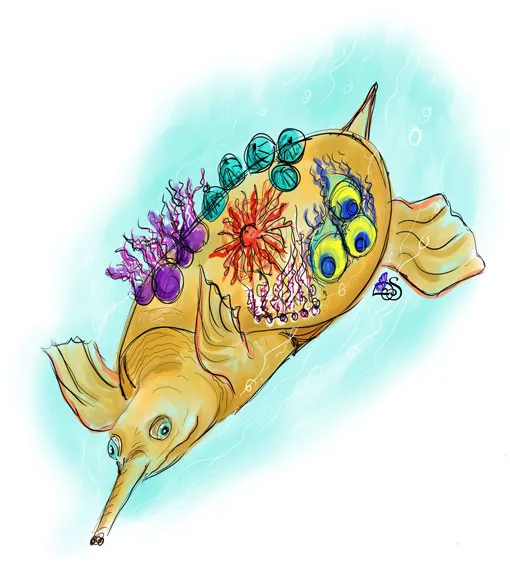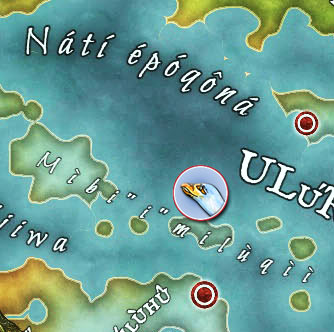"Mommy, look, the flowers are moving in the water!"
"Look again more closely. Can you see the little head and legs?"
"Oh yes, it's nibbling on a leaf. What is that, mommy?"
"The most beautiful creatures on the entire continent - turtles that dress themselves in coral."
- Four-year-old Qírīrī with his mother -
The underwater world of Ulűri̋qi̋ is teeming with corals and turtles of various types, sizes, colors, and shapes. However, there is only one species of turtle that supports anthozoan on its shell: the flower turtle. The Qírīrī consider them guardians of balance. They worship them like saints, believing that if these animals die, the end of the world will come.

Swimming Flower turtle by Blue Fairy 74
At a Glance
Scientific name:
Tho LIMIUTI oslopho
Common name: Flower turtle
Line: Turtles
Ancestry: Softshell
Habitat: shallow waters around Mìbi̋i̋milùqìì (Drop Islands)
Life expectancy: approx. 35 years
Size: approx. 60 cm shell length (wither height)
Weight: approx. 10 kg
Appearance: amber-colored soft keratin shell populated with cnidarians
Food: algae, small shrimp, fish
Reproductive maturity: approx. 4 years
Incubation: approx. 42 days
Offspring: approx. 20 eggs per clutch
Physiology
Flower turtles grow to about 60 cm in length and weigh an average of 10 kg. Males are slightly larger than females and have orange stripes along the underside of their limbs. Without the corals on their shells, they would probably be the most inconspicuous creatures in the shallow waters around the Teardrop Islands. Their skin and shell color match the amber sand, so they would hardly be noticeable if they shed their flowery camouflage and retreat into their shells. Unlike most of their relatives, the turtles' carapace is quite soft, which makes them easy prey for larger predators like red-mouthed snappers or spiny pike fish if they aren't hiding among the cnidarians.
Límíùtls have four paddle-like limbs with which they propel themselves, digging their shells into the sandy bottom right up to the edge of the coral colony. Their heads are large and equipped with a trunk-like, pointed mouth. The longer trunk is used for breathing and blends into their camouflaged symbiosis with the corals, so you have to look closely to see the difference when the turtle has retracted its limbs, with only its trunk sticking out, gently swaying with the coral's stinging flowers in the waves.
Harmonious lifestyle in symbiosis
Flower turtles feed primarily on siliceous algae that grow in shallow waters. This leads to the formation of the soft, keratin-containing carapace on which the flower animals settle. There are certain coral species that thrive on turtle shells. These include licorice anemones, mosaic needle corals, peacock eyes, rainbow sponges, stars of paradise, and several others. Most of these corals don't see themselves as competitors for food, so the shells may exhibit a colorful array of different shapes and colors.
The turtle's trunk is twice as long as that of the anthozoans and is considered a kind of fishing hook to attract prey.
Most of the corals feed on small shrimp, fish, snails, and amphipods that forage among the algae or are attracted by the trunk. The turtle's movements mean that the corals are not solely dependent on food in one location. The corals, in turn, provide the turtles with camouflage, protecting them from predators, and males also wear a kind of costume to attract attention during mating.

Motionless and hidden on the hunt by Blue Fairy 74
Reproduction & Development
Límíùtl reach sexual maturity at about 4 years. They live together in small colonies of about twenty to forty adults and young. According to the Ulűri̋qi̋an current calendar, when warmer currents wash around the Droplet Islands, the mating season begins. Males then swim along the coasts to find willing females in other colonies.
After the males have outmatched other rivals with their anthozoans and the female demonstrates her willingness to mate, the male stands on his hind legs and fertilizes the eggs via the female's cloaca. Even though the corals would survive on land for a few days without dying, this turtle species prefers beaches near sunny shores for its nests, which it can reach quickly. After about four weeks of gestation, approximately 20 amber-colored, hard-shelled eggs are laid in a hollow of warm sand during the cooler evening hours.
The incubation period lasts approximately 42 days. The young are immediately on their own after hatching and immediately seek shelter in the water, where they hide near algae. When the young's carapace has grown from approximately 3 cm to 15 cm in the first year, the first anthias begin to settle on the shells. The young then leave their hiding places and join the colonies nearby.
Did you know that...
there are differences between male and female turtles in the settlement of anthozoans?
male turtles have been observed attracting anthuriums from other rivals in order to look more attractive?
females give corals to males as a "wedding gift" to signal their willingness to mate?
young animals join their mothers' colonies in the first three years?

















A wonderful article, I adore this species, they sound so beautiful, majestic and unique. Also that opening quote was just far to adorable, it was perfect.
Thank you for your lovely comment. As I wrote this quote, I thought of my son and his first steps in discovering the world.
Here are my Entries for the water continent Ulűri̋qi̋